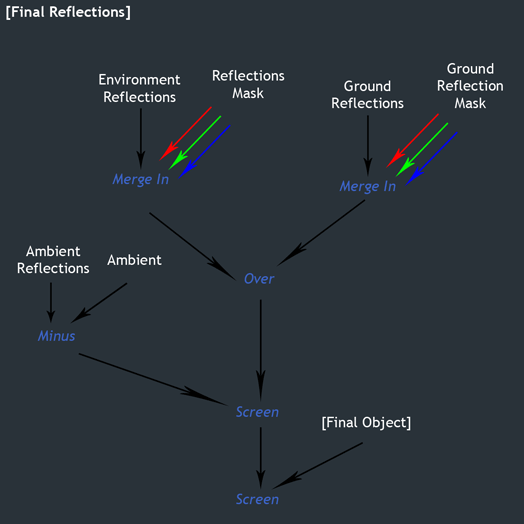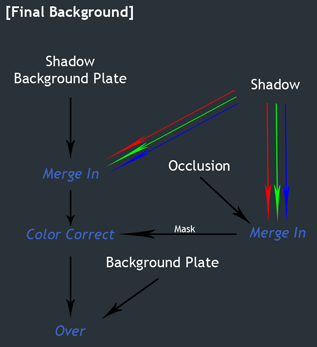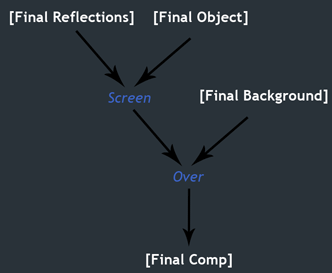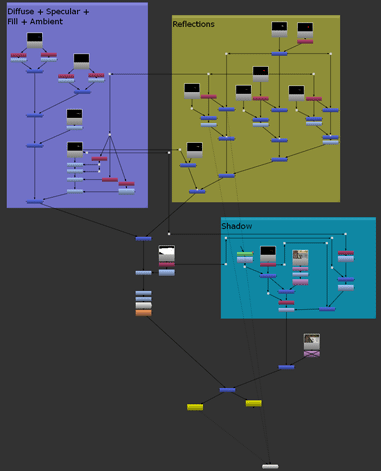Technical Direction for Compositing
Reflective Surfaces
Using a more reflective, but non-chrome object, we were to develop upon the basic compositing workflow developed in the previous project while expanding upon it with this whole new "branch" of visual data.
Tech Comp - Reflections from Sean Dooley on Vimeo.
Overview
For this project, I shot all of my own background and reference images and from what I learned in the previous project, I made sure to shoot a shadow background plate so I wouldn't have to paint anything. While I was encouraged to do a camera match move for this project, I was unable to do so because the little tiny point and shoot camera that I had access to didn't have a high enough quality video feature to make the effort really worth while. So I decided it would be better to skip the match move for this project and to carry it into my final project, which, sure enough, I did successfully, and at a much high resolution - almost full HD.
The addition of reflections was a significant challenge, especially since my object also dealt with varying levels of reflectivity. As a result, I needed to smartly work with masks to isolate each shader/component to more selectively control each component's reflectivity in post and to reduce the number of render layers necessary. In terms of compositing, to "add" the reflectivity into the traditional Nuke script created from the last project, the reflections need to be merged together and the final result of the reflectivity needs to be screened with the final results of the object. But before that happens, the self (or ambient) reflections need to be screened into the reflections at the end of the ground and environment reflections. To do that properly, the self reflections needs to first be subtracted from the ambient render layer. The result of that will leave only the self reflections which is then combined with the reflections like mentioned earlier. See below for a graph that'll visualize this concept.
Review
What I Learned/Challenges
- I learned about addressing reflectivity when it comes to compositing a CG object into a scene.
- I was challenged with dealing with multiple levels of reflectivity in a single object and managing the additional shaders in Maya and the additional render passes in Nuke.
- I was challenged to learn how to shoot more successful and complete background plate "resources". I learned a lot about what is necessary and helpful to the compositor and lighter when it comes to creating a believable integration.
Future Improvements
- I would like to work on demonstrating the self reflections more by including a second object in the scene to provide the knifes the ability to reflect onto each other.
- I would like to work on differentiating between the different levels of reflectivity between the different shaders further.
- I would like to address finer details such as a bump map for the knife blade itself - scratches and wear and tare on the blade essentially.
Technical Breakdown/Extra Information
Below is a simplified breakdown of the Nuke script. The first is what the addition of the reflection layers looks like. The second is a modification of the Final Background branch from the prior project's breakdown. And finally is the overall composite and merging of the different components.

The merging of the environment and ground reflections can repeat as |

Modifications to the [Final Background] tree. |

|
Below is what my node script actually looks like in it's entirety. For this script I started focusing more on developing better organization and making it clearer for a total view.

|
---------------------------------------------------------
This class focused on the development of a complex render layer and compositing workflow between Maya and Nuke. It took the traditional beauty pass and split it up into the individual elements for further control in Nuke. The first project focused on non-reflective objects (to show the basics to an object's integration) and then developed into reflective objects and surfaces. This class emphasized photorealistic compositing and integration through diverse controls and manipulations in post-production.
